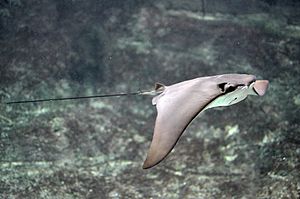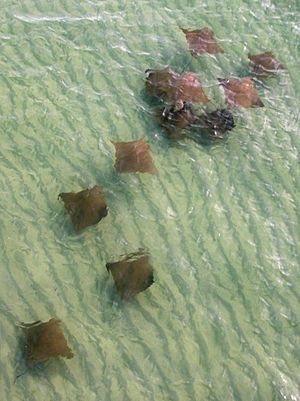Cownose ray facts for kids
- For other species of cownose rays, see Rhinoptera.
Quick facts for kids Cownose ray |
|
|---|---|
 |
|
| Conservation status | |
| Scientific classification |
The cownose ray (Rhinoptera bonasus) is a type of eagle ray. You can find it in a large part of the western Atlantic Ocean and Caribbean Sea. It lives from New England in the United States all the way to southern Brazil. Some cownose rays in the East Atlantic are now seen as a different species, called R. marginata.
Male cownose rays are often about 2.5 feet (76 cm) wide. Females are usually about 3 feet (91 cm) wide. But some rays have been seen up to 7 feet (2.1 meters) wide! Their size can change depending on where they live. Females usually grow bigger than males. This helps them have larger babies. Cownose rays belong to a group called Myliobatiformes. This group also includes bat rays, manta rays, and other eagle rays.
In 2019, the cownose ray was listed as "vulnerable" on the IUCN Red List. This means its population is decreasing and it might be at risk of disappearing.
Contents
What's in a Name?
The name Rhinoptera comes from ancient Greek words. Rhinos means "nose" and pteron means "wing." So, it's like "nose-wing." The species name bonasus comes from the ancient Greek word for "bison."
Appearance and Features
When a cownose ray is born, it is about 11 to 18 inches (28 to 46 cm) wide. A grown-up ray can reach about 45 inches (1.1 meters) wide. It can also weigh 50 pounds (23 kg) or more. Some very large rays have been recorded up to 84 inches (2.1 meters) wide!
People at the beach sometimes mistake cownose rays for sharks. This happens because the tips of their fins stick out of the water. They can look like a shark's dorsal fin.
A cownose ray usually has a brown back and a whitish or yellowish belly. Its shape is easy to spot. It has a wide head with eyes set far apart. It also has two special parts on its front fin that look like a cow's nose. Inside its mouth, it has strong dental plates. These are like flat teeth designed to crush clams and oyster shells.
If a cownose ray feels threatened, it can use a barb at the base of its tail. This barb helps it defend itself. The barb has small teeth along its sides. It is also covered with a mild venom. If you get stung, it feels similar to a bee sting.
How Cownose Rays Live
What They Eat
Cownose rays love to eat clams, oysters, and other small sea creatures. They have two special fins on their front side. They use these fins to create suction. This suction helps them pull food into their mouths. Then, they crush the food with their strong dental plates.
Cownose rays often swim in groups. When they do, they flap their "wings" together. This stirs up the sand and mud on the seafloor. This helps them find clams and oysters that are buried.
They prefer to feed in the early morning or late afternoon. At these times, the waves are calm and they can see better. Their strong jaws and hard teeth help them eat tough shells. The way cownose rays eat can be a problem. They are known for destroying oyster beds. These oyster beds are already at risk from human pollution.
Who Eats Them?
Cownose rays are quite high up in the food chain. This means they don't have many natural enemies. Their main predators include cobia fish, bull sharks, great hammerhead sharks, and sandbar sharks. Humans also fish for them.
Babies and Lifespan
Both male and female cownose rays can start having babies when they are about 4 to 5 years old. In the Gulf of Mexico, females can live up to 18 years. Males usually live up to 16 years.
Cownose rays breed from June through October. Large groups of rays gather in shallow waters. A female ray will swim with the edges of her fins sticking out of the water. Male rays will follow her, trying to grab her fins to mate.
The baby ray grows inside its mother. Its "wings" are folded over its body. At first, it gets food from an egg yolk. Later, the mother's body provides food for it. The time it takes for a baby ray to grow is thought to be between 11 and 12 months. When they are ready, the babies are born live, usually tail first.
Traveling Far
Cownose rays often migrate from the Gulf of Mexico to places like Trinidad, Venezuela, and Brazil. In the Atlantic, they move north in late Spring. Then they travel south in late Fall.
Their migration might be affected by water temperature and the sun's position. This helps explain their seasonal travel. Moving south might be guided by the sun. Moving north might be guided by changes in water temperature.
Scientists are not sure if they migrate to find food or to mate.
Cownose rays are also found in areas like Maryland and Virginia. You can often see them migrating and swimming in schools. They sometimes swim near the surface, even though they mostly feed on the bottom. These schools can be seen from airplanes. This helps track their movements. However, the exact reason for their long migrations is still a mystery.
Where They Live
Cownose rays live naturally in the Eastern and Western Atlantic Ocean. In the Eastern Atlantic, you can find them near Mauritania, Senegal, and Guinea. In the Western Atlantic, they live from Southern New England to Northern Florida in the United States. They are also found throughout the Gulf of Mexico, Trinidad, Venezuela, and Brazil.
They live in brackish (a mix of fresh and salt water) and marine (saltwater) habitats. They can be found at depths up to 72 feet (22 meters). They are social animals and travel very long distances. They often swim together in large schools.
Protecting Cownose Rays
The cownose ray is currently listed as "vulnerable" by the IUCN Red List. This is because too many are being caught by fishing in the Caribbean. They are less threatened in the Gulf of Mexico and along the Atlantic coast of North America. However, their overall population has dropped by 30-49% in just 43 years. Because of this, cownose ray killing contests have been banned in Maryland.
Rays and Humans
Are They Dangerous?
Stingrays, including the cownose ray, can be a low to medium risk to humans. If a ray feels threatened, it will whip its tail. This can cause a painful lash. It can also use its barb to sting. A sting from a cownose ray can be very painful and might need medical help. While a sting is usually not deadly, it can be if it hits the stomach area.
There is also a risk if you eat ray meat that is not cooked properly. You could get a sickness called shigellosis from bacteria called Shigella. This can cause diarrhea, pain, fever, and dehydration.
Fishing for Rays
One idea to help with the cownose rays destroying oyster beds, or if there are too many in some areas, is to allow more commercial fishing for them. However, catching them is hard and expensive. Also, not many people want to eat ray meat. So, this idea might not be profitable for fishermen. Still, people who fish for fun often catch them. In the Caribbean and near Venezuela, too many rays are being caught. This has led to a population drop of up to 49% in the last 43 years.
Rays in Aquariums
Cownose rays can be seen in many public aquaria around the world. They are often in special "touch tanks." In these tanks, visitors can reach into a wide, shallow pool to touch the fish. The rays in touch tanks often have had their barbs gently trimmed or removed. This makes them safe to touch. Their barbs grow back, just like human nails.
Here are some aquariums and zoos with cownose ray touch tanks:
In the USA
- Adventure Aquarium in Camden, New Jersey
- Albuquerque Aquarium in Albuquerque, New Mexico
- Audubon Aquarium in New Orleans, Louisiana
- Arizona-Sonora Desert Museum in Tucson, Arizona
- Atlantic City Aquarium in Atlantic City, New Jersey
- Aquarium of the Pacific in Long Beach, California
- Butterfly House and Aquarium in Sioux Falls, South Dakota
- California Academy of Sciences in San Francisco, California
- Children's Aquarium at Fair Park in Dallas, Texas
- Clearwater Marine Aquarium in Clearwater, Florida
- Columbus Zoo and Aquarium in Powell, Ohio
- Downtown Aquarium, Denver in Denver, Colorado
- Georgia Aquarium in Atlanta, Georgia
- Henry Doorly Zoo in Omaha, Nebraska
- Indianapolis Zoo in Indianapolis, Indiana
- Kansas City Zoo in Kansas City, Missouri
- Living Shores Aquarium in Glen, New Hampshire
- Long Island Aquarium and Exhibition Center in Riverhead, New York
- Lowry Park Zoo in Tampa, Florida
- Marine Science Center in Ponce Inlet, Florida
- Maritime Aquarium in Norwalk, Connecticut
- Mystic Aquarium in Mystic, Connecticut
- The New England Aquarium in Boston, Massachusetts
- New York Aquarium in Brooklyn, New York
- Newport Aquarium in Newport, Kentucky
- North Carolina Aquarium at Pine Knoll Shores in Emerald Isle, North Carolina
- Ocean Adventures in Gulfport, Mississippi
- Oklahoma City Zoo and Botanical Garden in Oklahoma City, Oklahoma
- Phoenix Zoo in Phoenix, Arizona
- Rooster Cogburn Ostrich Ranch in Picacho, Arizona
- Saint Louis Zoo in St. Louis, Missouri
- San Antonio Aquarium in San Antonio, Texas
- SeaWorld Orlando in Orlando, Florida
- Shedd Aquarium in Chicago, Illinois
- Tennessee Aquarium in Chattanooga, Tennessee
- Texas State Aquarium in Corpus Christi, Texas
- Toledo Zoo in Toledo, Ohio
- Tropicana Field in St. Petersburg, Florida
- Turtle Back Zoo in West Orange, New Jersey
- Wonders of Wildlife Museum & Aquarium in Springfield, Missouri
- ViaAquarium in Rotterdam, New York
- Virginia Aquarium in Virginia Beach, Virginia
- Greensboro Science Center in Greensboro, North Carolina
In Canada
- Aquarium of Quebec in Quebec City
- Granby Zoo in Granby
- Ripley's Aquarium of Canada in Toronto, Ontario
- The Vancouver Aquarium in Vancouver, British Columbia
- Assiniboine Park Zoo in Winnipeg, Manitoba
See also
 In Spanish: Raya gavilán para niños
In Spanish: Raya gavilán para niños
Froese, Rainer, and Daniel Pauly, eds. (2005). "Rhinoptera bonasus" in FishBase. August 2005 version.




